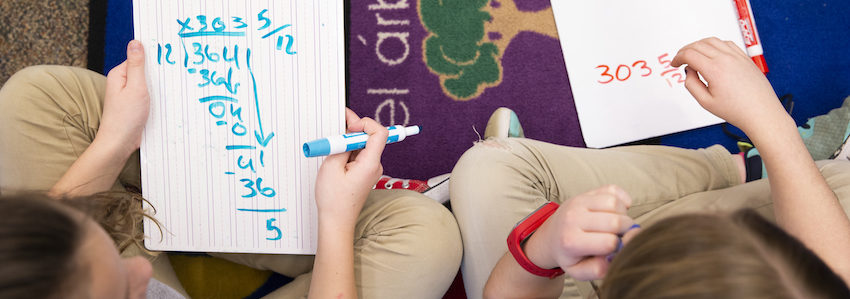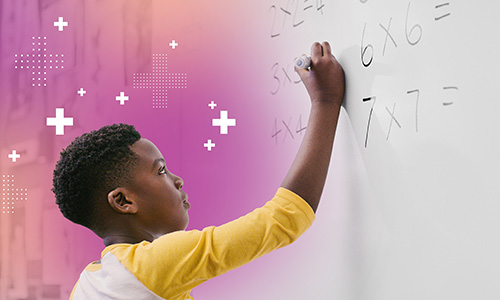
Math content and skills build along increasingly complex progressions, and without learning supports, students can fall behind very quickly. The range of learning differences, strengths, and needs just in one class can feel overwhelming for a teacher as well. Making sure all students experience the best-fit learning supports during class is important yet hard work. So, what can we do?
I sat down with Doug Buttorff, a secondary math teacher and teacher-leader known to his students as Mr. B, to get his thoughts. Why Mr. B? Because my own daughter was lucky enough to take his class, and he helped her resolve unfinished learning in algebra and demonstrate that she could meet rigorous content standard expectations. Perhaps even more importantly, her attitude about math shifted from negative to positive. Mr. B’s answers have been edited for length and clarity.
What exactly does “integrating learning supports for success” mean to you as a math teacher?
To me, learning supports are tools in a toolbox that my students and I can use together. The toolbox is full of approaches, strategies, and mechanisms that can help all students thrive as we tackle math content standards together. My math class toolbox is organized into at least two sections. This is so that my students and I can easily find and utilize what’s best.
One section of the math class toolbox contains supports that must be used. These are tools that align to the expectations outlined in legally mandated accommodation and modification documents, like IEPs or 504 plans. I read and review these routinely because many of the legally mandated supports for individual students can benefit other students, too.
Here’s an example: Your daughter’s plan includes allowing for extra time or quieter spaces to complete math tasks. These supports are helpful for several other students, so I make sure to craft procedures that allow your daughter as well as any other student to have them. (This helps me out, too, because I can save prep time by using ideas from the legally mandated plans with students in general, when appropriate. For more on this, read “3 ways gen ed teachers can support students with disabilities.”)
The second section of my math class toolbox contains additional supports that are not outlined in those legally mandated plans but are beneficial for all students. This section of the toolbox includes tools for math engagement, representation, and action and expression, following Universal Design for Learning (UDL) Guidelines.
Here’s another example: I noticed your daughter was really interested in Tetris, and it also fascinated several other students. I was able to use that information to make connections between the game and concepts we were working on in class. These connections helped your daughter and the other students make meaning that was motivating to them. Tetris became an engagement support in our toolbox.
What inspired you to use this toolbox approach with your students?
When I was a student, I didn’t know where to go for help when I got stuck. I didn’t know what pieces I was missing, and that resulted in the feeling, “I guess I am just bad at math,” so I stopped practicing.
Two math educators made a huge difference. The first was a middle school teacher who knew my friends and I were fans of Dungeons and Dragons. The teacher helped us improve our math fluency in operations by borrowing terminology from the game and talking in terms of hit points (addition and subtraction) and chained combos (multiplication). The teacher showed us these tools, kept them available in our toolbox, and helped us use them as learning supports. Then, in college, I had a professor use fantasy baseball to help me make sense of statistics.
I noticed there are still so many students like me when I became a teacher. Students can do math, but there may be a strong emotional response that can be a barrier, and we can’t assume students have the best-fit tools or know how to use them.
Why is it so important that math teachers integrate learning supports into their lesson plans and day-to-day actions with all students?
Too many students still feel that they “can’t do math” and internalize that story. Math seems to have a common fixed mindset associated with it. Because this emotional response is still common, it’s important that all math educators, not just specialists, are equipped to recognize and address it.
For more about fixed mindsets in math and how we can work with students to shift to “un-hate” math, check out “The mythical math gene: 5 ways to build growth mindset.”
How do we integrate learning supports for success with formative and summative assessment?
Many of the learning support tools already in the toolbox from other parts of the learning journey will also help with classroom assessment, such as self-assessment, feedback, quizzes, and tests. In fact, when learning supports are part of everything we do, students will already have access to and practice with best-fit learning tools when it comes time for assessment.
There are a few things to check for to be sure all students have what they need for success with assessment processes, though. For a list of things teachers will want to be sure to have in place, our readers should see your article “5 ways to check classroom assessment processes for quality.” Math educators can also use formative conversation starters with students to empower them to practice thinking habits, making meaning, and problem solving.
Here are two specific considerations I also learned to use with assessment:
- How many tasks or questions are enough?
- What are the alternative options students can use to express their thinking?
I credit your daughter with helping me remember this. During exercises, quizzes, or tests, she would put her head down. When I asked her for help understanding what was getting in her way, I remembered that sometimes there were just too many written response questions. In some cases, she didn’t need so many questions, and she could explain her thinking faster verbally instead of in writing. She was shutting down because she (rightfully!) felt bogged down. So I cut back the volume, and I provided verbal response opportunities. These are examples of following UDL Guidelines for representation and action and expression.
These learning supports were not reserved just for your daughter. She helped me remember to add these options to our toolbox. It was a great reminder for me of how a quick conversation with one student can help update the toolbox with best-fit learning supports that are helpful for multiple students during the learning journey, including during assessment.
Now you might be wondering, do other students get angry when some students don’t have to do all the questions or do the questions in the same way? No, but this is because we do a lot of work strengthening our learning culture,which includes building trusting relationships. When we have trusting relationships, we can work as a team to find and use learning supports that are equitable. Students can see that although they might not need a specific support on one assessment, such as verbal options, they might need other learning supports, such as additional time. With this trust, there is a lot less resistance and reluctance and there are a lot more learning gains and shows of agency.
Planning your next steps
I am so glad Mr. B could take the time to share his wisdom. I hope you can start by celebrating how you already use these approaches in your daily practice. When you’re ready, I recommend trying at least one new idea. Here are some questions that can help you decide on next steps:
- How do I already effectively integrate learning supports into math classes with my students?
- What is at least one new idea from this blog post or the embedded resources that I could try next?
- Who can help me try out at least one new idea? (My team or PLC members? An instructional leader? A mentor? My students?)
- How can my administrator help me with this work?
- Who can help me advocate for and receive the support I need to do this work?







